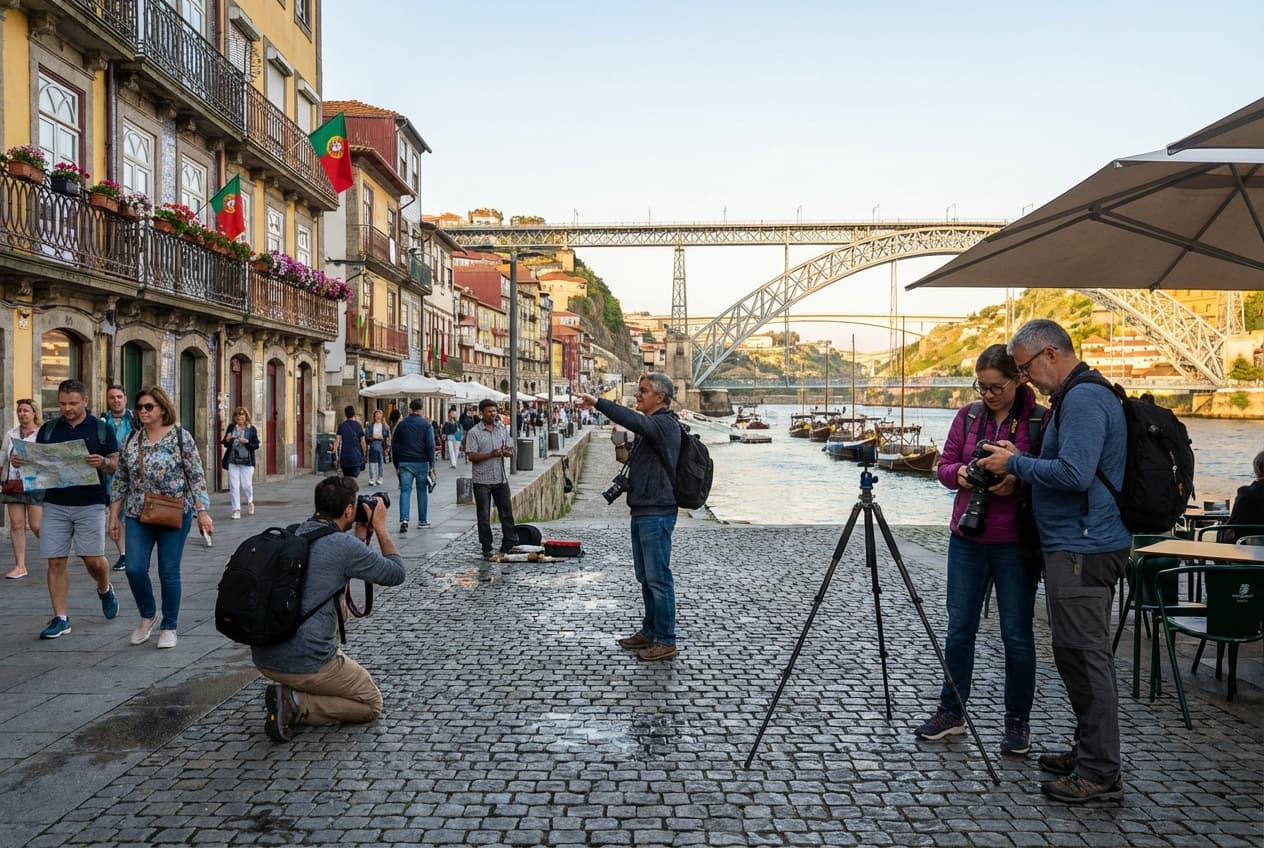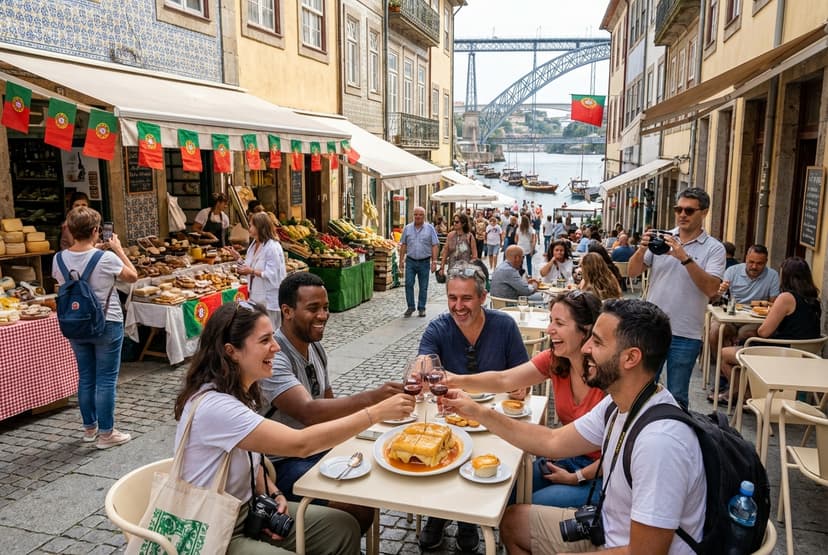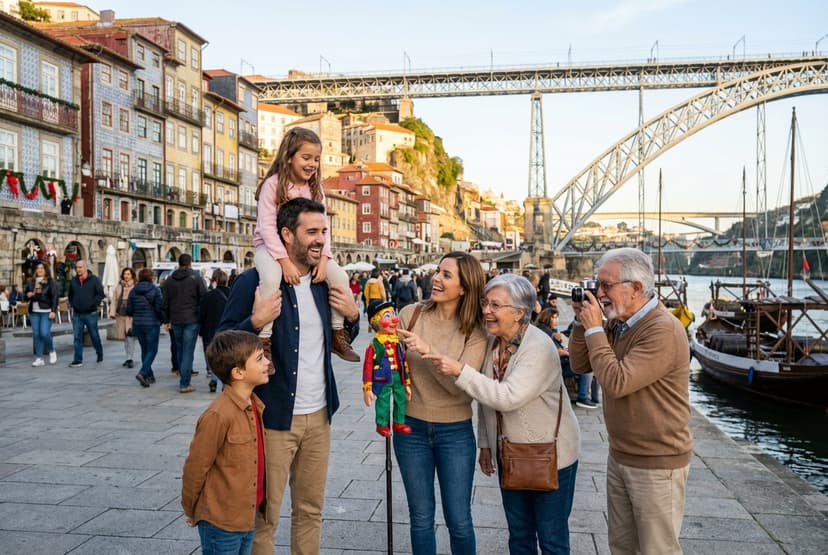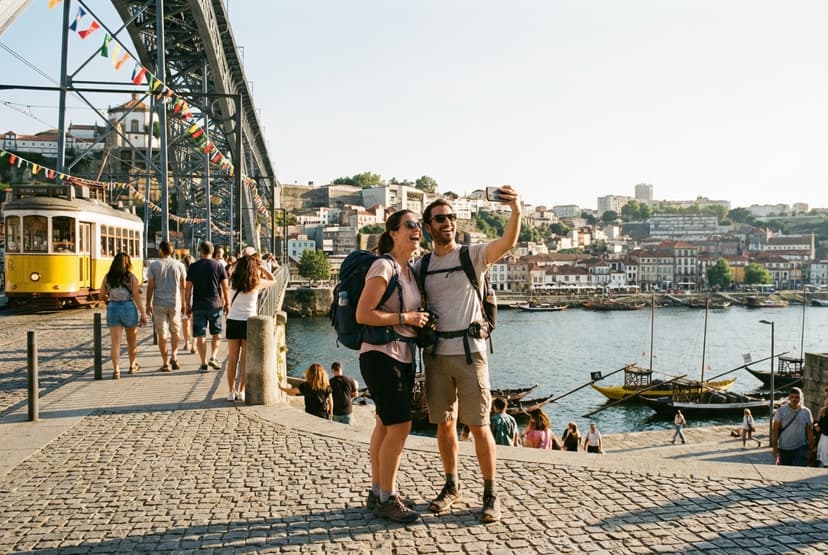Porto in Frames — 3-Day Photography Itinerary (November)

A photographer-focused 3-day route through Porto timed for sunrise on the Douro and sunset views from Gaia. Includes Ribeira streets, tile-covered churches, Dom Luís I Bridge, vintage trams, and seaside landscapes. Hour-by-hour lighting tips and must-shoot angles included, with insider notes and practical permits/booking reminders for this November (Autumn) visit.
Highlights
- Sunrise on the Douro at Cais da Ribeira
- Tile-covered churches (Igreja do Carmo, Capela das Almas, Capela das Almas façade)
- Dom Luís I Bridge — top & lower decks
- Miradouro da Serra do Pilar (sunset over Porto)
- Vintage trams & Museu do Carro Eléctrico
- Seaside sunrise at Farolim de Felgueiras & Praia de Matosinhos
- Hidden gems: Palácio de Cristal gardens, Serralves park, Gaia wine cellars
Itinerary
Day 1
Arrival day built around sunrise shoots on the Douro and an evening sunset from Vila Nova de Gaia. Focus on classic Porto compositions and low-light prep for November shorter days.
Sunrise shoot — Cais da Ribeira (Douro waterfront)
Pre-dawn setup on the Cais da Ribeira to photograph reflections on the Douro as the city warms into light. Lighting suggestions: arrive 30–45 minutes before official sunrise for pre-dawn blues (~soft cool tones), continue through golden hour (warmer side-lit façades). Must-shoot angles: (1) low tripod over the quay stones for foreground leading lines and reflections of Ribeira buildings; (2) wide landscape including Dom Luís I Bridge and river curve from the east end of the Cais; (3) verticals of colorful façades with moored boats for layered texture. In November expect cooler light and potential morning mist over the river—bring weather protection for gear.
Tips from local experts:
- Accessibility & crowd tip: arrive early (at least 30–45 min pre-sunrise) to avoid tour-boat crews and morning pedestrians; the stones can be slippery when wet—use a small tripod with spiked feet or rubber covers.
- Lens & exposure tip: bring a wide 16–35mm (or equivalent) and a 70–200mm for compressed bridge shots; bracket exposures for high dynamic range (river reflections vs. bright sky).
- Local logistics: there is no permit for handheld/triopod street photography here, but drone use requires ANAC authorization and local municipal permission—plan ahead if flying.
Breakfast & gear check — Café Progresso
Warm up with coffee and a light breakfast while culling first shots and changing cards/batteries. Lighting suggestion: use this window to review exposures and plan midday indoor shots; avoid leaving batteries in cold pockets overnight in November. Must-shoot angle: the café interior offers classic Porto café portrait backdrops if you want environmental shots of photographers at work.
Tips from local experts:
- Battery care: bring a warm jacket pocket for spare batteries — cold & damp November mornings reduce battery life.
- Editing quick-check: pick 6–10 keeper frames to compare white balance and horizon tilt before you head into narrow streets.
- Accessibility: small café with limited seating — arrive earlier than typical locals (09:15) to secure a table and plug for laptop/card reader.
Ribeira streets & alleys — walking photo walk
Wander the narrow cobbled lanes of Ribeira for intimate street and architectural frames. Lighting suggestion: mid-morning side light is softer in November—good for texture in façades and tile patterns. Must-shoot angles: (1) tight frames of laundry lines and painted doors; (2) staircases leading to river with people for scale; (3) details: weathered tiles, iron balconies, door knockers. Stay flexible for spontaneous portraits of vendors and fishermen.
Tips from local experts:
- Crowd avoidance: mid-morning is ideal—later the Ribeira gets busier with river cruises; keep one eye on the quay for incoming tour groups.
- Permission & portraits: ask politely before photographing close-up portraits (a smile and a quick demo of the photo helps); carry small change if you plan to buy a quick prop (bread, pastry) from a stall.
- Gear hack: bring a 35mm or 50mm prime for low-light alleys and a lightweight sling bag to move quickly between compositions.
Lunch — Adega São Nicolau (Ribeira)
A relaxed lunch in the heart of Ribeira. Use this break to recharge and sort morning cards. Lighting suggestion: shoot food/drink in window light where possible; November daylight through windows is cooler—adjust white balance accordingly.
Tips from local experts:
- Table placement: ask for a window or corner table with river views for natural light food shots.
- Workflow tip: set aside one SD card to carry with you (not in camera bag) to avoid losing all files if a bag is compromised.
- Local flavor: try an honest plate of francesinha or grilled fish—good foreground props for environmental food photography.
Tile-hunt — Igreja do Carmo & Capela das Almas façades
Photograph Porto's celebrated azulejos. Lighting suggestion: late afternoon side light brings out tile relief—avoid high noon where specular highlights flatten color. Must-shoot angles: (1) wide façade frames including street context; (2) close-up patterns and grout texture; (3) low-angle shots to include sky and rooftop lines. In November, watch for overcast days—cloudy light is excellent for reducing glare on glossy tiles.
Tips from local experts:
- Order & crowd tip: Igreja do Carmo can be busy; shoot the outside façade early/late to avoid tour groups and use a polarizer to control reflections.
- Stability: bring a small travel tripod for long exposures of interiors if allowed (check church policy for tripods indoors).
- Alternative frame: if the main façade is crowded, turn to the side alleys for intimate tile details and repeating patterns.
Golden hour & sunset — Miradouro da Serra do Pilar (Vila Nova de Gaia)
Cross the Dom Luís I bridge to Gaia for the classic Porto sunset silhouette. Lighting suggestion: arrive 45 minutes before sunset to compose bridge-and-city panoramas, shoot through golden hour into blue hour to capture lights turning on (bridge lights and riverside reflections). Must-shoot angles: (1) wide panorama from Serra do Pilar with the entire Dom Luís I Bridge and Ribeira; (2) telephoto compression of clustered rooftops against the river; (3) silhouette of bridge structure with sun/starburst if the sun aligns—use small aperture (f/11–f/16). In November the sun sets earlier (roughly 17:15); check local times and weather.
Tips from local experts:
- Permits & access: Miradouro area is public (no fee) but the most iconic vantage points can be small — scout 1–2 alternative spots on the terrace to avoid blocking locals or other photographers.
- Tripod & safety: November winds at the viewpoint can be strong—use a weight or strap your tripod and keep gear covered when not shooting.
- Alternate viewpoint: if Serra do Pilar is crowded, walk 5–10 minutes east to Jardim do Morro for slightly lower elevation and different bridge framing.
Dinner — Taberna dos Mercadores (historic Porto)
Evening meal back in Porto. Use dinner to back up files and plan the next day's seaside session. Lighting suggestion for night shots: review blue-hour images on a laptop and note highlights/areas to re-visit.
Tips from local experts:
- Booking: small popular restaurant—reserve ahead if possible, especially in November when indoor dining is preferred.
- Image backup: during dinner, transfer RAWs to a backup drive or cloud service and format used cards to avoid confusion.
- Night portraits: if you plan portraits after dinner, use small LED panels or a reflector to balance face light against shopfronts.
Day 2
A day for seaside dawns, vintage tram character, local markets and expansive park viewpoints. Keep flexibility for changing November skies and blue-hour river shots.
Sunrise at Farolim de Felgueiras (Felgueiras Lighthouse)
Capture the Douro mouth light and crashing Atlantic at the lighthouse. Lighting suggestion: arrive 30–45 minutes pre-sunrise for long exposures of waves (silky water) and continue through golden hour for warm cliff-side light. Must-shoot angles: (1) long-exposure foreground rocks with lighthouse as secondary subject; (2) low-angle wave splashes frozen with fast shutter for dramatic water droplets; (3) panorama combining river mouth and ocean horizon.
Tips from local experts:
- Tide & safety: check tide times—best wave drama is at mid/high tide but be mindful of slippery rocks and sneaker waves.
- Filters: bring ND filters for multi-second exposures and a polarizer to reduce spray glare.
- Access: the jetty can be exposed in November winds—wear waterproof shoes and keep camera bag elevated to avoid splashes.
Breakfast — Café Guarany (Avenida dos Aliados area)
Historic café for a photographer-friendly break; good natural light for relaxed portraits and gear checks. Lighting suggestion: morning side light through large windows is soft and warm in November.
Tips from local experts:
- Historic interiors: if you want interior shots, ask staff politely; some are happy to let you photograph the art deco décor.
- Quick charge: ask to plug in while you eat—many cafés permit it if you buy a meal.
- Keep it light: eat and leave with a plan to head to the tram/museum while light is still good for exteriors.
Vintage trams — Museu do Carro Eléctrico & Line 1 ride
Photograph historic trams, interiors, and scenic riverside tram runs. Lighting suggestion: mid-morning window light is ideal for interior shots; exterior tram portraits work well with shutter near 1/250–1/500 to freeze motion. Must-shoot angles: (1) diagonal compositions of trams climbing streets; (2) interiors with vintage seats and handrails for detail shots; (3) wide river-side tram runs showing sea or river context.
Tips from local experts:
- Ride timing: the active Line 1 scenic run fills up—board early for empty-carriage frames and to shoot through windows without many reflections.
- Museum permissions: tripods inside the museum may be restricted—ask at the desk; small monopods are often tolerated.
- Lens choice: use a 24–70mm for interior/exterior flexibility and a polarizer for windows when shooting through glass on tram runs.
Lunch & local life — Mercado do Bolhão
Colorful market for vibrant portrait and detail work (fish, vegetables, vendors). Lighting suggestion: market stalls have mixed light—use a slightly higher ISO and a fast prime (f/1.8–f/2.8) to capture atmosphere. Must-shoot angles: (1) overhead stall patterns; (2) vendor portraits with shallow depth of field; (3) environmental shots including building façades.
Tips from local experts:
- Respectful shooting: ask for permission for close portraits—many vendors enjoy talking and will pose if asked politely.
- Lens selection: a 50mm or 85mm prime is excellent for quick candid portraits with pleasing bokeh.
- Avoid peak crowds: visit just after midday when many locals step out; November market rhythms are calmer than summer.
Palácio de Cristal gardens — mid-afternoon & overlooking the river
Expansive gardens and terraces with multiple viewpoints over the Douro—great for golden-hour scouting. Lighting suggestion: late afternoon in November yields long soft shadows—excellent for layered compositions and portrait sessions among formal gardens. Must-shoot angles: (1) framed views through plane-tree alleys; (2) terraces overlooking the river for wide cityscapes; (3) intimate details: gates, benches, and trimmed hedges.
Tips from local experts:
- Scouting: use this time to map compositions for blue hour later—note where lights will come on across the river.
- Lens plan: bring a mid-tele (70–200mm) for compressed cityscapes and a wide for garden scenes.
- Little comforts: there are sheltered spots for umbrella use in November showers—carry a lightweight rain cover for kit.
Blue hour & light trails — Dom Luís I Bridge (lower & upper decks)
Photograph the bridge lit against the blue sky and the riverside reflections. Lighting suggestion: shoot from blue hour into early night (roughly 17:15–18:30 in November) to capture warm artificial light contrasting with cool sky. Must-shoot angles: (1) from the lower riverside looking up at the bridge with light trails from vehicles; (2) from the upper deck for panoramic night vistas; (3) long exposures from the Ribeira quay capturing illuminated façades and their reflections.
Tips from local experts:
- Tripod etiquette: the upper deck can be windy and busy—use a compact tripod and be mindful of pedestrian flow.
- Shutter settings: try 6–12s exposures to smooth the river and capture light streaks, bracket to retain building highlight detail.
- Crowd avoidance: head to the bridge earlier than sunset for positioning; alternatively shoot from the eastern quay for fewer people.
Dinner — Casa d'Oro (riverfront dinner with views)
Italian-style riverside dinner with good evening light for river reflections—an easy wrap to the day. Lighting suggestion: use the river lights and interior lamps for moody food/environmental portraits.
Tips from local experts:
- Window seating: request a window/terrace table for unobstructed river views and ambient light.
- Evening gear: use a small LED for subtle fill when shooting handheld food or couple portraits at dusk.
- Plan tomorrow: while eating, consult next day's sunrise timing—November sunrise is later than summer.
Day 3
Final day for seaside landscapes, contemporary architecture, Gaia wine cellars and a final sunset viewpoint. Leave room for spontaneous detours—November weather can provide dramatic skies.
Sunrise — Praia de Matosinhos (beach and pier)
Wide ocean horizons and long piers for minimalist compositions at dawn. Lighting suggestion: soft horizontal light at sunrise in November creates long shadows—ideal for leading-line compositions. Must-shoot angles: (1) pier leading line centered composition; (2) low-angle sand textures and reflected sky; (3) silhouettes of early surfers and fishermen with rising sun.
Tips from local experts:
- Commuting tip: Matosinhos is a short metro/tram ride—leave hotel early to arrive at least 30 minutes pre-sunrise for easy compositions.
- Sand & gear care: avoid changing lenses on the beach—sand is abrasive; bring a blower and lens cloth.
- Weather check: Atlantic mornings in November can be foggy—embrace it for moody minimalist frames, and pack a rain cover.
Seafood market & brunch — Mercado Municipal de Matosinhos
Capture fish-market energy and enjoy a fresh seafood brunch. Lighting suggestion: indoor, mixed lighting—use a fast prime and raise ISO as needed. Must-shoot angles: (1) vendor portrait with catch; (2) overhead tray patterns of fish and crustaceans; (3) candid chef or prep action shots.
Tips from local experts:
- Permission & timing: vendors are friendlier earlier—shoot quickly and show images to build rapport.
- Props: use small neutral props (napkin, lemon wedge) to style seafood for close-up shots.
- Storage: if shooting RAW, immediately back up your cards after brunch to avoid data risk.
Serralves Gardens & Contemporary Architecture (Fundação de Serralves)
Contrasting modern architecture and landscaped parkland—excellent for minimalist and architectural frames. Lighting suggestion: mid to late morning in November yields directional light through trees—use it for strong shadow patterns. Must-shoot angles: (1) low-angle museum lines against sky; (2) framed tree alleys leading to sculptures; (3) reflections in the park ponds.
Tips from local experts:
- Tickets & tripod rules: the museum often requires ticketed entry and may restrict tripods inside galleries—tripods are usually allowed in the gardens but check on arrival.
- Weather & reflections: after November rain the ponds have excellent reflection opportunities—bring a polarizer to control glare.
- Lens choices: a tilt/shift or perspective-correcting lens is useful for architecture; a 24–70mm handles both landscapes and details.
Lunch — O Gaveto (Matosinhos seafood classic)
Hearty seafood lunch and a chance to rest before the afternoon transfer back to Gaia for cellar visits. Lighting suggestion: shoot plated seafood near window light; natural side light is flattering for texture.
Tips from local experts:
- Book ahead: popular with locals for seafood—reserve a table to avoid long waits.
- Props & color: use simple wooden boards or white plates to emphasize seafood texture and color.
- Rest & review: use this time to sort through images and make a 'shoot list' for the afternoon Gaia session.
Afternoon transfer & Gaia wine cellars (Caves Sandeman) — cellar tour and rooftop scouting
Visit larger port wineries for interior details and rooftop views over Porto. Lighting suggestion: cellars are dim—use high-ISO, fast lenses, and a monopod; rooftop terraces are ideal for late-afternoon scaffolding shots and pre-sunset framing. Must-shoot angles: (1) barrel-line leading lines inside the cellar; (2) intimate low-light barrel/label details; (3) rooftop panorama of Porto with stacked rooftops and bridge.
Tips from local experts:
- Booking & access: many caves require advance booking for tours and rooftop access—book the afternoon slot and request rooftop access at booking time.
- Low-light technique: use fast primes (35/50/85mm f/1.8 or faster) and bring a small continuous LED if allowed for fill detail (ask staff first).
- Permission & composition: be mindful of tour groups—shoot barrel detail during quiet moments and use a longer focal length to isolate details.
Final sunset & blue hour — Miradouro da Serra do Pilar / Jardim do Morro (Vila Nova de Gaia)
One last sunset over Porto from Gaia. Lighting suggestion: aim to capture from golden hour into blue hour again (sunset in November ~17:15); focus on long panoramas and slowly increasing exposure times as lights come on. Must-shoot angles: (1) full panorama with Dom Luís I Bridge illuminated; (2) vertical bridge details with river reflections; (3) environmental portraits with the city as backdrop in blue hour.
Tips from local experts:
- Less crowded alternative: if the main terrace is busy, walk to Jardim do Morro for a slightly different angle and fewer people.
- Bracket & stack: bracket exposures for a final HDR panorama and consider focus-stacking for extreme depth-of-field cityscapes.
- Night transport: plan your return (walk or taxi) in advance—November evenings are chilly and sometimes rainy, so have a warm layer and dry covers.
Farewell dinner & backups — Taylor's Port Lodge (Vila Nova de Gaia)
Finish with dinner in Gaia, final image backups and a relaxed review of highlights. Lighting suggestion: the lodge's terrace and lamps provide warm ambient light—good for atmospheric last frames.
Tips from local experts:
- Final backup: spend 20–30 minutes backing up selects to a second drive and confirming battery charge for departure.
- Relax & reflect: take a few environmental portraits around the lodge terrace to end the trip with human context frames.
- Transport planning: confirm your transfer to the airport or next destination before leaving the lodge to avoid evening delays.







